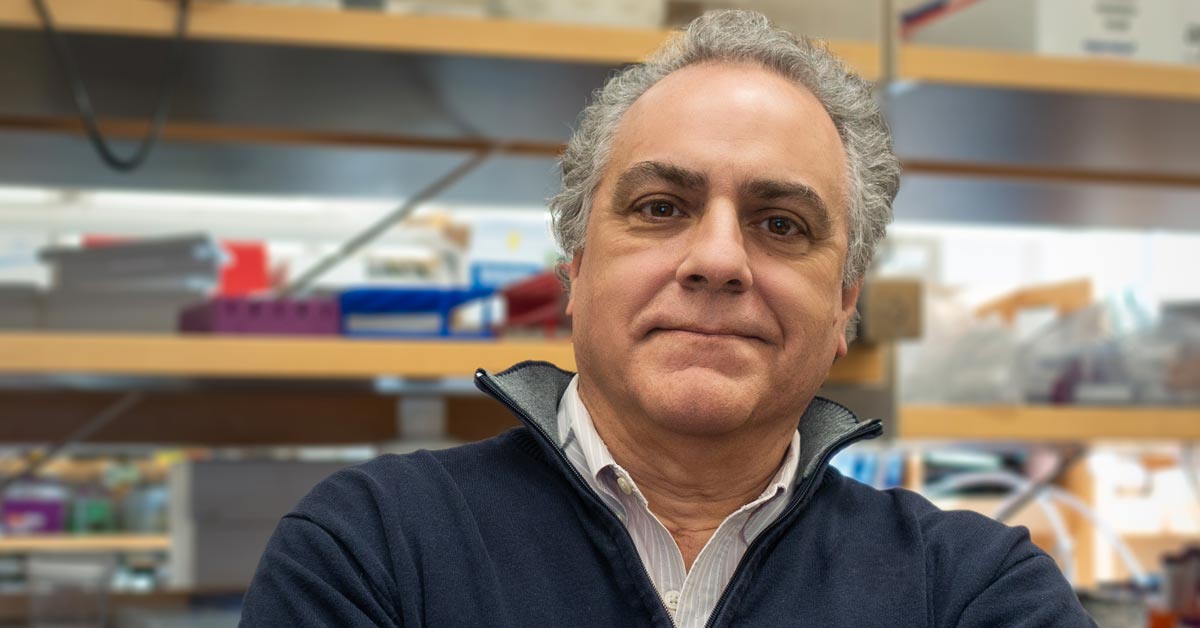Pilot Grant Program 2022
Developing a Targeted Therapy for Acute Myeloid Leukemia
Principal Investigator: Lucio Castilla, PhD

Targeted cancer therapies are potent tools for selectively eliminating cancer cells and improving outcomes while minimizing side effects. Seeking to extend these benefits to inversion(16) acute myeloid leukemia (AML), Lucio Castilla, PhD, is developing a small molecule therapy that may benefit about 5-10% of patients with AML. Inversion(16) AML—also known as inv(16) AML—arises from a chromosomal inversion that repositions and joins the core binding factor ß (CBFß) and smooth-muscle myosin heavy chain (SMMHC) genes. Inv(16) AML is characterized by a disruption in blood cell development and has a 5-year survival rate of about 60% (20% in elderly patients).
The CBFß-SMMHC fusion protein binds to the runt-related transcription factor 1 (RUNX1) gene and blocks its ability to regulate the differentiation of hematopoietic cells. Indeed, to function correctly, RUNX1 must be able to attach to a non-mutated form of CBFß, but the configuration of CBFß-SMMHC precludes that event.
Dr. Castilla previously characterized how the small molecule AI-10-49 efficiently binds to the fusion protein CBFß-SMMHC and blocks its binding to RUNX1. Since RUNX1 binding is essential for the oncogenic activity of the fusion protein, this block efficiently eliminates the AML cells by activating cell death pathways. However, because AI-10-49 is hydrophobic, it is prone to precipitation at the injection site and, therefore, is a poor candidate for use in humans.
But, Dr. Castilla didn’t let this complication stop him.
We just need a way to preserve AI-10-49 after injection so it can travel to the target AML cells and get to work.
Forming the perfect collaboration
Dr. Castilla recognized that encapsulating AI-10-49 in a protective carrier, such as a nanogel, would ensure its efficient delivery to leukemic cells. To do so, he needed a partner. With support from the UMass Cancer Center Pilot Grant Program, Dr. Castilla and his team collaborated with S. Thai Thayumanavan, PhD, an expert in polymer assembly design for drug delivery at UMass Amherst. Dr. Thayumanavan's lab has a demonstrated ability to develop stable nanogels capable of penetrating cells and releasing their cargo.
The collaboration between Dr. Castilla and Dr. Thayumanavan ensures a comprehensive assessment of the nanogel's ability to safely encapsulate and deliver AI-10-49 to leukemic cells and evaluate its efficacy in treating AML.
To further enhance the drug's targeting ability, the team drew on the knowledge that the antigen CD117 is highly expressed on inv(16) AML cells. Therefore, affixing an antibody for CD117 to the surface of a nanogel encapsulating AI-10-49 (thereby forming an antibody-nanogel conjugate–ANC11749) allows for the delivery of AI-10-49 into these cells through endocytosis, enhancing the drug's efficacy and minimizing off-target effects.
Testing, testing, testing
Rigorous preclinical testing is essential before progressing to clinical trials. At the outset, the research team tested the efficiency of the nanogels in eliminating leukemic cells and studied their stability while circulating in the blood. Then, they ensured that the nanogel alone was not toxic to healthy mice. This work confirmed their specificity and stability in cells and mice. Next, they will transplant leukemic cells into mice and determine how long the onset of leukemia is delayed in mice treated with nanogels carrying AI-10-49 to the AML cells, and if the addition of anti-CD117 will increase their target specificity.
“The real test is whether the onset of leukemia is delayed when we use just AI-10-49. The anti-CD117 allows for more specific targeting of the inv(16) AML cells, but if the leukemia is delayed for just as long without that addition, then it may not be necessary—which would cut down on the cost,” says Dr. Castilla.
Upon determining which option is most efficacious, the team plans to seek funding for patient-derived xenograft (PDX) studies involving the implantation of patient tumors into immunodeficient mice and ultimately seek partnership with a private company to bring the drug to clinical trials.
Eyeing the finish line
Developing a drug targeting inv(16) AML cells significantly improves patient outcomes. By addressing the challenges posed by inv(16) AML and harnessing the potential of targeted therapies, researchers like Dr. Castilla are paving the way for more effective and personalized treatments in the fight against leukemia.